|
|
Ard Patrick

|
|
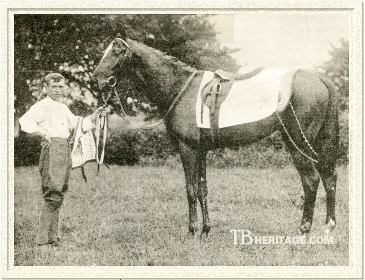 |
|
|
Good horses are judged not only by their performances on the track or in the breeding shed, but also by the company they keep. Based on these criteria, Ard Patrick was an exceptionally good horse. He has come down in history as the horse that defeated Sceptre and Rock Sand in the epic Eclipse Stakes of 1903. Ard Patrick was more than that. He was a Derby winner, a half-brother to Triple Crown winner Galtee More. His talent was such that even his own trainer had difficulty choosing which horse, Ard Patrick or Galtee More, was better. At stud in Germany, where top class stallions Hannibal, Nuage, Dark Ronald, and Galtee More were also enjoying marked success, Ard Patrick led the German sire list multiple times and exerted his own influence on the development of the German thoroughbred, especially through the produce of his daughters.
Ard Patrick was the third classic winner bred by Captain John Gubbins from his Springfield mare Morganette. Gubbins, a jump jockey in his youth, owned and operated Bruree Stud and Knockany Studs, adjacent properties in the Golden Vale of County Limerick, Ireland. He began breeding chasers and hurdlers, but in 1879 he started to breed flat racers. Morganette (1884), "mean looking and muley," had started once, running unsuccessfully in Goodwood's Prince of Wales's Stakes, already showing signs of being a roarer, and was put up for sale by her owner-breeder J.H. Houldsworth. Not put off by her looks, her dismal track performance, and her wind infirmity, Gubbins took a chance on her. Morganette's foals included Irish Derby winner Blairfinde (1891) and English Triple Crown winner Galtee More (1894), both by Gubbins' stallion Kendal.
Gubbins had also purchased St. Florian (1891) as a stallion. He was a son of St. Simon out of Palmflower, by The Palmer and was a half-brother to Oaks winner Musa. St. Florian was lightly raced and won only one of eight career starts in two seasons, the Duke of York Handicap at Kempton Park, as a three-year-old in 1894, in which he finished ahead of the fine filly Throstle. St. Florian also finished second to Derby winner Ladas in the Newmarket Stakes. St. Florian's stud career was tragically brief. In delicate health, St. Florian was very ill when Morganette was brought to him, and it was suggested to Gubbins that perhaps another stallion should be coupled with the mare. Gubbins insisted upon St. Florian and the mating went ahead as planned. Fortunately Morganette caught to his cover, as within a week, St. Florian, age seven, was dead. The next year, 1899, Morganette dropped Ard Patrick.
St. Florian's offspring included Scullion (1898), a winner of the Ascot Stakes of over two miles in 1902, and the Manchester Cup (in a dead-heat) in 1904; Fabulist (1897), a winner of the Liverpool Autumn Cup; and St. Helena (1898), a winner at two of the National Stakes at The Curragh. His daughter Queen's Bower (1899), was a winner of Wolverhampton's Bushbury Maiden Plate, placed second in Liverpool's Paddock Plate and Doncaster's Scarborough Stakes, and third in the Ascot Biennial and Newmarket's Houghton Handicap in seven starts at age three. She was the dam of Qu'elle est Belle, winner of the classic French Prix de Diane and later second dam of American full brothers Chance Shot and Chance Play. As a broodmare sire, St. Florian was also represented by Two Thousand Guineas winner Slieve Gallion (from Reclusion, 1898, juvenile winner of two plates at the Curragh); Demure, winner of the Cesarewitch; Duke Michael, winner of the Champagne Stakes at Doncaster, and the multiple stakes-winning sprinter Golden Song,
Ard Patrick was a large-framed brown colt with two white hind coronets and a white star and stripe down his face. The colt was not as solidly built as his elder half-brother, Galtee More, appearing more lean and lithe. Slightly bent hocks were all that marred the colt's overall appearance. Like Galtee More, this son of St. Florian and Morganette was named for a local landmark, namely Ard Padraig, a tiny village in County Limerick located at the foot of the north slopes of the Ballyhoura Mountains, on the edge of the Golden Vale.
Ard Patrick on the Turf
Ard Patrick was sent to the yard of Sam Darling at Beckhampton in Wiltshire, the trainer who guided the turf career of Galtee More. Darling instantly recognized that Ard Patrick, with his gangly frame that he was still growing into, would not come to hand as precociously as Galtee More had done and brought the colt along slowly. Consequently, Ard Patrick did not make his racecourse debut until the autumn of his two-year-old year, in the Imperial Plate at Kempton Park. It came as no surprise that Ard Patrick ran green, and it was due to the skilled ride of Danny Maher that helped Ard Patrick win his debut by a short head over Royal Lancer, a highly regarded Royal Hampton colt owned by Sir Blundell Maple who was toting thirteen more pounds than the Irish colt. Only four days later, Ard Patrick benefited from his experience and ran a better race to win the Clearwell Stakes at Newmarket, again beating Royal Lancer, who this time was conceding Ard Patrick three pounds. In his final outing as a two-year-old, the Dewhurst Plate at Newmarket, Ard Patrick was beaten a neck by the more experienced Gallinule filly Game Chick while conceding her two pounds. Game Chick was no mean opponent, as she carried wins in the Imperial Produce Stakes at Kempton Park and the Champagne Stakes at Doncaster, the latter over the brilliant filly Sceptre.
Put away for the winter, Ard Patrick grew into his big frame, but was backward and slow to come to hand and still green in his training. It says much for his raw talent and courage that he performed as well in the Two Thousand Guineas as he did. The favorite for the race was Robert Sievier's filly Sceptre, already winner of the One Thousand Guineas and on course for an ambitious attempt by her owner to sweep all five English classics with the same horse. The filly moved a step closer to that goal, winning the Two Thousand Guineas effortlessly by two lengths from the Carbine colt Pistol, with Ard Patrick another three lengths back in third place.
A week later, Ard Patrick was sent after the May Plate at Kempton Park and finished second while conceding twenty-one pounds to the winner Royal Ivy. Next came the ten furlong Newmarket Stakes in which Ard Patrick came in first, only to be disqualified when the rider of Fowling Piece lodged an objection against Ard Patrick's rider Mornington Cannon. Despite the loss at the hands of the Newmarket stewards, Ard Patrick benefited physically from the race and was sent on to Epsom and the Derby a much fitter animal to face Sceptre and the rest of the field than he had been at Newmarket only weeks before.
On Derby Day, Ard Patrick was fit and trainer Darling and owner Gubbins were eagerly anticipating a top effort from their colt. Sceptre, on the other hand, was fretting and did not break well as a result, causing her rider, Herbert Randall, to push her to make up the lost ground. Ard Patrick, under J.H. “Skeets” Martin, enjoyed a perfect trip, and he and Sceptre hooked up at Tattenham Corner. The excitement of a duel between the two lasted only momentarily, as Sceptre's exertions in the early part of the race told on her and she dropped back to finish a weary fourth as Ard Patrick went on to win by three lengths from second place Rising Glass. Sceptre's legion of fans had to settle for a consolation prize when the filly easily won the Oaks two days later.
Ard Patrick went from the Derby to the Prince of Wales's Stakes at Royal Ascot. On the way to the starting post, Ard Patrick slipped on a newly laid turf patch and faltered so badly it was thought he had broken down. Allowed to start when it appeared he was none the worse for wear after the incident, he failed to run to expectations and was beaten by Cupbearer. The latter was disqualified for interference and Ard Patrick this time benefited from the action of the Ascot stewards and was awarded the race. It was only modest consolation after it was discovered Ard Patrick seriously sprained a tendon. This injury to his leg was to trouble him for the rest of his racing career. Confined to a walking regimen, Ard Patrick was declared out of the St. Leger, won by Sceptre, giving her an unprecedented four out of five victories in the English classics. Ard Patrick was seemingly recovered enough to start in the Jockey Club Stakes at Newmarket that autumn, but he ran a lackluster third to Rising Glass, whom he had beaten easily in the Derby.
|
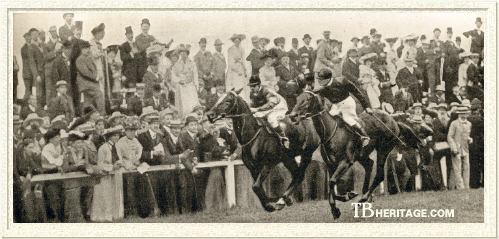 | | Ard Patrick (Left) beats the great Sceptre (Right) by a neck in the Eclipse Stakes (Rock Sand is nowhere) |
The main goal for Ard Patrick as a four-year-old was the rich Eclipse Stakes at Sandown Park in July. He was given a thorough rest over the winter, with plenty of time to allow his doubtful leg to heal. He made his four-year-old debut in the Princess of Wales's Stakes at Newmarket and won easily, setting him up perfectly for the Eclipse. Set to start in the Eclipse in addition to Ard Patrick were Sceptre, fresh off a win in the Hardwicke Stakes at Royal Ascot, and the best three-year-old of the year, Rock Sand, winner of the Two Thousand Guineas and Derby. The race turned out to be an epic struggle for supremacy between Sceptre and Ard Patrick. The two slugged it out through the home straight, and at the winning post, Ard Patrick had the edge over his distaff rival by a neck, with Rock Sand finishing a well-beaten third.
Ard Patrick in the Stud
The Eclipse proved Ard Patrick's final race. His doubtful leg again troubled him and he was retired from the turf with a record of six wins in eleven lifetime starts. While his retirement was sad news for his fans, it was welcome news for Georg von Lehndorff, the Director of the German Imperial Stud and William Allison, a bloodstock agent, both of whom had been in negotiations with Gubbins for the sale of Ard Patrick for stud in Germany. A price of £20,000 was agreed upon, along with the proviso that Gubbins could race him until the end of his four-year-old season. His retirement after the Eclipse Stakes allowed the Germans to take possession of him immediately, and soon Ard Patrick was safely installed in his new home in Germany, the Government Stud at Graditz (later moved to Altefeld).
Asked to compare Ard Patrick and Galtee More as to which was the better, trainer Sam Darling concluded, "I have never been very emphatic which was the better. Galtee More had a thickening of the tendon under the knee, and this at different times caused me no little anxiety, and in the end was the cause of my not training him as a four-year-old for the Gold Cup at Ascot. The benefit of the doubt would probably be given to Ard Patrick."
The sale of Ard Patrick to foreign interests caused no little consternation among Irish and British breeders, especially as Gubbins had sold the colt's half-brother, Triple Crown champion Galtee More, to the Russians only five years before. Gubbins was in declining health, suffering greatly from gout, an affliction that contributed to his death in 1906. In part due to his disintegrating health, he was not greatly troubled by the sale of his champions, taking the best offers made for each.
Galtee More would soon join Ard Patrick in Germany, as he was purchased from the Russian government after several successful years there. Upon arrival in Germany, he was installed at the Imperial Stud at Graditz. These two stallions were to exert a profound influence on the German thoroughbred. Ard Patrick led the German sire list four times (1909, 1911, 1913, and 1914) and Galtee More once (1910).
Ard Patrick was the sire of four German classic winners and the broodmare sire of eight more. These twelve horses won a total of fifteen German classics. The first of Ard Patrick's classic performers was the filly GLOCKENSPIEL (1906), out of Girton Girl, by Royal Hampton. Lightly-raced, her only victory came in the Deutsches St. Leger, in which she dead-heated for the victory with Galtee More's son Fervor. GLOCKENSPIEL produced very little as a broodmare, her best being the Nuage colt Glockenturm (1916), a dead-heat winner with the Fervor colt Lorbeer in the Jubiläums-Preis at Hoppegarten as a three-year-old. Glockenturm sired no recorded progeny.
GRANADA (1911), a sister to GLOCKENSPIEL, was lightly raced. The best she could do was two placings in minor stakes. At stud, however, she became the dam of Gibraltar (1916), a brown colt by Nuage, that won the Deutsches Derby, one of Ard Patrick's classic-winning grandchildren.
LETIZIA (1907) was a bay filly produced from the imported Kendal mare Ladyland. As a two-year-old, she won the Hamilton Stakes at Baden-Baden over another Ard Patrick filly named SCHLUSSNOTE. At three, she landed her biggest prize when she won the Preis der Diana at Hoppegarten. It was a sweep for Ard Patrick that day, as the second and third place finishers LOCKUNG and REGINA CASTRA were also daughters of his. LETIZIA also took the Frankfurter Gold-Pokal at three and the Preis der Stadt Baden at Baden-Baden at four, defeating Galtee More's son Fervor in the process.
As a broodmare at Carl and Arhtur Weinberg's Gestüt Waldfried, LETIZIA became the dam of a colt by Fels named Lentulus (1919). Lentulus accounted for the Preis des Winterfavoriten at two, and at three took the classic Henckel-Rennen, the Union-Rennen, and was second to Abgott in the Deutsches St. Leger.
The fillies that finished behind LETIZIA in the Preis der Diana, LOCKUNG and REGINA CASTRA, were also stakes winners. LOCKUNG (1907), out of Lockvogel, by Fulman, took the Ard Patrick Rennen at Hoppegarten and the Chamant-Rennen at Koln that season. REGINA CASTRA (1907), out of Royal Footstep, by Royal Hampton, was victorious in the Stuten-Biennial 1909/1910 at Hoppegarten and the Grosses Wiesbadener Handicap at Wiesbaden. As a broodmare she produced the filly Reichenau (1915), by Dark Ronald. Reichenau was a winner of the Austria-Preis at two and the Österreichisches Derby at three.
TERMINUS and ARIEL, both foaled in 1911, proved to be rivals on the racetrack. The former was produced from Tay, by Bend Or, while the bay ARIEL was a son of the Little Duck mare Ibidem, bred at Gestüt Schlenderhan and owned by the von Oppenheim family. At age three TERMINUS was victorious in the Henckel-Rennen (German Two Thousand Guineas) and the Grosser Preis von Hamburg, and ARIEL took the Grosser Hansa-Preis, but in the three times they met at that age, ARIEL beat TERMINUS -- in the Union-Rennen, the Hoppegartener Jubiläums-Preis, and the Deutsches Derby -- and it was ARIEL that became the champion money-winning colt of 1914. ARIEL had also been a high-class juvenile, accounting for the Sierstorpff-Rennen, Renard-Rennen, and Oppenheim Memorial, and kept in training until age five, later won the Preis von Donaueschingen.
|

Ariel
|
|
In the stud ARIEL got the filly Odaliske (1923). A half-sister to the future champion Oleander, Odaliske was a winner of the Hamburger Criterium at two and then third to the Fervor filly Faustina in the Kissasszony-Rennen at three. Odaliske went on to become the dam of two classic winners: 1938 Deutsches Derby winner Orgelton (by Prunus) and his year-younger half-brother Octavianus (by Wallenstein), winner of the Österreichisches Derby and the Deutsches St. Leger. ARIEL was also the sire of 1924 Henckel-Rennen winner Mofalcone; 1921 Hamburger Criterium winner Mariele; Preis des Winterfavoriten winner Revolutionar (1920); and Marquise (1921), second to the Fervor filly Hornbori in the Deutsches St. Leger of 1924. |
TERMINUS, who stood for several years as a stallion in the Union-Gestüt, sired very little of note at stud. His sister, TAMPA (1910), won the Alexander-Rennen at Frankfurt and the Hertefeld-Rennen at Hoppegarten, and was a good third to Majestic and Fabella in the Grosser Preis von Berlin. Her best offspring was the Fels colt Tannenfels (1917), a high-class juvenile that was second place finisher in 1919 in both the Preis des Winterfavoriten and the Sierstorpff-Rennen.
Ard Patrick's son MARABOU (1906), out of Mirza, by Chamant, bred and raced by the national stud at Graditz, was a multiple stakes winner in his native Germany and a classic winner in Hungary. His best season came at three in 1909, when he took the Nickel-Rennen at Hamburg, the Grosser Preis von Hannover at Hanover, and the Grosser Preis von Leipzig at Leipzig, defeating the Galtee More colt Fervor in the latter race. His classic score came in the Magyar St. Leger at Budapest. His wins in 1909 made him the champion earner of his year. MARABOU sired no recorded progeny.
|
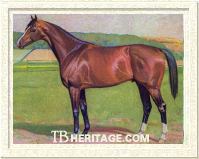
Dolomit
|
|
DOLOMIT (1909), a handsome brown horse with white ankles and a blaze, was produced from the Saphir mare Danubia. Bred by the Gestüt Schlenderhan, he was raced with considerable success from the ages of two through five. In some of his races at age two, Dolomit was partnered by American ex-patriate jockey Jimmy Winkfield, who emigrated from America to enjoy a successful riding career first in Russia (where he rode several of the offspring of Ard Patrick's brother Galtee More to important victories) and then transferred his tack to Germany and continued winning important races. |
Aboard DOLOMIT, Winkfield won the Rheinisches-Zuchtrennen at Koln. DOLOMIT'S other victories at two included the Renard-Rennen at Hoppegarten, the Preis des Winterfavoriten, and the Hammonia-Preis at Hamburg, which made him the leading money earner in Germany in 1911. At three, DOLOMIT'S biggest victory came in the Grosser Preis von Berlin, at four in the Kincsem-Rennen at Berlin, and at five in the Grunewald-Rennen and the Jubiläums-Preis at Hanover. Returned to the farm of his birth at Gestüt Schlenderhan, DOLOMIT had limited success, and was eventually sold to another stud in Germany before finally being sold to the Hungarian National Stud at Kisber. He died in 1924 at the age of fifteen.
OCTOPUS (1909), out of Ohnesorge, by Hannibal, was not of classic caliber, but nevertheless performed well, accounting for the Borsteler Herbst-Pokal at Hamburg in a dead-heat with the Galtee More colt Eccolo at three, and finishing third in both the Union-Rennen and Grosser Preis von Hamburg that same season, and winning the Klassen-Eksatz-Preis in Berlin at four. Like many of Ard Patrick's sons born just before the war, he is not recorded as having sired any progeny.
|
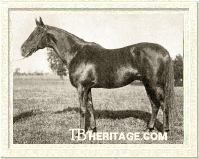
Huon
|
|
Classic-placed HUON II (1905) was out of the Isonomy daughter Hyeres. He raced through the age of six, winning at three the Grosser Preis von Hannover, running third in the Deutsches Derby and second in the Deutsches St. Leger, winning the Chamant-Rennen at Hoppegarten at four, and the Damen-Preis at Baden-Baden at both five and six. Huon II stood stud first in England and then was exported to the United States where he enjoyed moderate success, getting over thirty winners. His most notable performers were the American steeplechaser Billy Barton and Dolan, a winner of the 1928 Suburban Handicap over champions Chance Shot and Scapa Flow. |
Other important stakes winners by Ard Patrick included ABENDROTHE (1905, out of Abendglocke, by Chamant), winner at two of the Hamilton-Stakes at Baden-Baden and the Dresdener Jugend-Rennen at Dresden; ANKLANG (1905, out of Alveole, by Crafton), winner of the Grosser Preis von Hamburg at three; and LAPIS LAZULI (1906, out of Legality, by Isonomy), winner of the Hoppegartener Jubiläums-Preis at Hoppegarten at three over HUON II and Faust.
Very few of Ard Patrick's sons made a mark as stallions, but one, LUCULLUS (1908, out of Lucca, by Cazabat), was an excellent stallion in New Zealand, and was leading sire in 1927-28, and sixth on the list of sires (progeny earnings) for the decade of the 1920s. LUCULLUS had done nothing on the turf in his native Germany, and was sold to India, where he was a failure. He was resold and shipped to England. At the July 1914 Newmarket Sales he was picked up for 25 guineas by New Zealand breeder J.O. Hayward, and once again took ship to the east. He ended up as a stallion for William Walters in the Waikato (New Zealand), where, due to the incredible versatility and toughness of his offspring, he rose in the sire's lists, getting horses of all ages that could win over all distances and any track conditions. Many of his colts and fillies held their form and were winners over successive seasons.
LUCULLUS' winners included the 1928 Great Northern Steeplechase winner Glendowie, Pegaway (1921, ARC Easter Handicap, ARC Club Handicap, Clifford Plate), Queen March (1920, ARC Great Northern Champagne Stakes, Welcome Stakes, Royal Stakes, and the WRC Wellesley Stakes), Nancy Lee (1921, ARC Railway Handicap), Tuahine (1921) and Pompey (1920, both winners of the Avondale Guineas), King Lu (1922, ARC Great Northern Guineas), Master Doon (1921, ARC Railway Handicap, Waikato Cup), and Missgold (1916, ARC Great Northern St. Leger). He was also a successful broodmare sire. His daughter Miss Muriel produced New Zealand Derby winner Nightly (1930, by Night Raid), also a winner of the CJC Canterbury Cup, the DJC James Hazlett Gold Cup, and other races, and later successful sire of stakes-winning stayers. LUCULLUS' daughter Queen March later bred Limarch (1930, by Limond), a winner of the AJC St. Leger and a stallion in Australia.
However, it was a sire of broodmares in Germany that made Ard Patrick's influence on the thoroughbred significant.
|
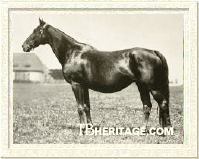
Antwort
|
|
His best daughter was undoubtedly ANTWORT (1907), out of Alveole, and so a full sister to Grosser Preis von Hamburg winner ANKLANG. She was bred at the Imperial Stud at Graditz. She proved a brilliant two-year-old, notching victories in the Landgrafen-Rennen at Frankfurt, the Zukunfts-Rennen at Baden-Baden, the Renard-Rennen at Hoppegarten, and the Rheinisches Zucht-Rennen at Koln. At three, she was classic-placed, finishing third to colts Micado II and Hornist in the Henckel-Rennen. It was as a broodmare, however, that ANTWORT truly excelled, for she became one of the most important mares in twentieth century German breeding history. |
ANTWORT became the dam of no less than four German classic winners, and a fifth foal, Anschluss, was the champion money-winner in Germany at age four. Her classic winners were Adresse (1913), a bay filly by Nuage; the black filly Aversion (1914), also by Nuage; the brown colt Abschluss (1916), by Biniou, and the bay filly Aplenrose (1919), by Nuage. ANTWORT was second dam to two other German classic winners and third dam of yet another. Beyond that, her daughters were dams or second dams of several leading sires in Germany, extending Ard Patrick's influence well into the future.
Her daughter Adresse was a winner of the Renard-Rennen as a juvenile, and then blossomed at three to take the Preis der Diana and the Deutsches St. Leger. She was second in the classic Henckel-Rennen and the Goldene Peitsche, and third in the Deutsches Derby. As a broodmare, she was dam of stakes-winning siblings by Dark Ronald in Axenstein (1918), Abenteurer (1919), and Askari (1925). Her daughter Antonia (1926, by Herold) was a winner of the Preis der Diana and became the dam of Abendfrieden (1934, by Ferro), winner of the Deutsches Derby, Deutsches St. Leger, and the Magyar St. Leger in Hungary. Abendfrieden enjoyed a successful career at stud, siring several German stakes winners, including 1943 Deutsches St. Leger winner Aufbruch.
ANTWORT'S daughter Aversion was victorious in the Deutsches St. Leger and third in the Preis der Diana. Like her dam, she was a multiple classic producer, her daughter Aditja (1925, by Fervor) capturing the Preis der Diana and son Alchimist (1930, by Herold), who counted the Deutsches Derby, Union-Rennen, Grosser Preis von Berlin, and Grosser Preis von Baden among his victories.
As a stallion, Alchimist was twice leading German sire, in 1946 and 1947. His best representatives on the racecourse included his daughter Schwarzgold (1937), dual classic winner of the Kisasszony-Rennen and Preis der Diana; Hannenalt, winner of the 1938 Kisasszony-Rennen; and Aralia (1945), winner in 1948 of the Preis der Diana, the same year the Deutsches Derby was won by Alchimist's son Birkhahn. Alchimist was broodmare sire of four further German classic winners. Alchimist died during the Russian occupation of Germany. His son Birkhahn went on to become leading sire in Germany three times, in 1967, 1968, and 1970. Birkhahn in his turn was sire of Priamos, two-time leading German sire (1980 and 1982).
Another good performer out of Aversion was the Dark Ronald colt Aditi (1922), winner of the Grosser Preis von Hamburg and Grosser Preis von Baden at three and second in both the Deutsches Derby and Deutsches St. Leger. At four, Aditi took the Grosser Hansa Preis. He sired several stakes horses in Germany, but made a mark as a broodmare sire. Mares by Aditi produced Tatjana (1936, by Ferro), victorious in both the Kisasszony-Rennen and Preis der Diana, and Ticino (1939, by Athanasius), winner of the Deutsches Derby. Ticino became one of most important German stallions of the post-war era, siring fifteen German classic winners and leading the German sire list a total of nine times between 1950 and 1958. Two sons of Ticino, Neckar and Orsini, led the German sire list six times and four times, respectively.
ANTWORT'S son, Abschluss (1916, by Biniou), was a winner of the Deutsches St. Leger and a moderate sire. Then there was her daughter Alpenrose (1919), a Nuage filly and a full sister to Adresse and Aversion. As a juvenile, she took the Zukunfts-Rennen and the Oppenheim-Rennen. At three, she became her dam's fourth classic winner by virtue of her victory in the Preis der Diana. Her other victories included the Deutscher Stutenpreis and the Furstenberg-Rennen and a second place finish in the Deutsches Derby. Alpenrose produced only one recorded foal.
The fifth stakes winner produced from ANTWORT was the black colt Anschluss (1912, by Nuage). At three, he won the Hoppegartener Jubiläums-Preis and was third in the Deutsches Derby. He took some time to mature and did not reach his full potential until age four, when he captured the Chamant-Rennen, the Hoppegartener Jubiläums-Preis for the second time, and the Grosser Preis von Hamburg and Grosser Preis von Berlin, and took his place at the top of the list of leading German earners that year. Despite limited opportunities at stud, he sired Goldene Peitsche winner Grossinquisitor (foaled 1922) and Marduck (1922), winner at three of the Hoppegartener Jubiläums-Preis and at four of the Renard-Rennen.
An unraced daughter of ANTWORT, the Nuage filly Arachne (1920) became the dam of Artischoke (1932), a filly by Herold. As a two-year-old, Artischoke was victorious in the Preis des Winterfavoriten, and at three, ran a gallant third to the brilliant Oleander colt Sturmvogel in the Henckel-Rennen.
|
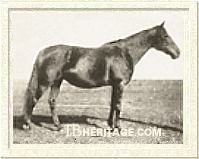
Hornisse
|
|
Another influential daughter of Ard Patrick was the bay HORNISSE (1908), out of Hortensia, by Ayrshire, owned by the German national stud at Graditz. As a two-year-old, she won the Leipziger Stiftungs-Preis at Leipzig. At three, she took the Eintracht-Rennen at Hamburg and the Stuten Biennial at Hoppegarten. Her foray into classic company yielded a second place finish in the Preis der Diana to her stablemate, the Caius filly Angostura. HORNISSE, as a broodmare for Graditz, produced only three recorded foals in her career as a broodmare, all by Dark Ronald. |
Her son Herold (1917) insured her place in the annals of German breeding. Herold, a brown, nearly black colt, started out his three-year-old campaign with a second place finish in the Henckel-Rennen, but then emerged as the dominant colt of his generation, capturing the Deutsches Derby, Deutsches St. Leger, Grosser Preis von Berlin, and the Gladiatoren-Rennen.
Sent back to the place of his birth, Gestüt Graditz, Herold became an extraordinarily successful stallion, leading the German sire list twice, in 1931 and 1933.
Herold was the sire of several German classic winners, including the previously mentioned Deutsches Derby champion Alchimist and Preis der Diana winner Antonia. Son Lupus (foaled 1925) was victorious in the Deutsches Derby and Deutsches St. Leger and son Dionys (foaled 1928) took laurels in the 1931 Deutsches Derby. Arjaman, winner of the 1933 Deutsches St. Leger, led the German sires list in 1949. Another son, Effendi, took the 1942 Henckel-Rennen. Daughter Lenhsherrin (foaled 1931) was victorious in the Preis der Diana and later became the dam of another winner of the same race when her daughter Leibwache (by Wahnfried) won the 1942 edition. As a sire of broodmares, Herold also did exceptionally well, his daughters producing the German classic champions Leibwache, Abendfrieden, and Poet (1941), a winner of the Henckel-Rennen.
The last of Ard Patrick's daughters to produce a German classic winner was ARABIS (1915). This bay filly was an unraced full sister to Deutsches Derby winner ARIEL, both being out of Ibidem, by Little Duck. ARABIS produced Alba (1927), a bay colt by Wallenstein. Bred and raced by the Oppenheim family's Gestüt Schlenderhan, Alba was defeated only once during his racecourse career, that loss coming in his first start. As a three-year-old, Alba was victorious in virtually every major race on the German racing calendar. He swept the Henckel-Rennen, Deutsches Derby, Union-Rennen, Furstenberg-Rennen, Grosser Preis von Baden and the Grosser Preis von Berlin. He was lost to German breeding when, on his last training gallop before the Deutsches St. Leger, he fractured a hind leg and had to be put down. He was the leading earner in Germany in 1930.
As bitter a pill Alba's premature death was to swallow, German breeders at least had consolation in the fact that ARABIS produced two fillies who went on to make important contributions to the German thoroughbred. Alba's sister Arabella (1926) became the dam of Allgau (1940, by Ortello), winner of both the Deutsches Derby and Österreichisches Derby, while his half-sister Arabeske (1929, by Wallenstein), herself a winner of the Deutscher Stutenpreis, was second dam of both Asterios (1947, by Oleander), winner of the Henckel-Rennen and Deutsches St. Leger and Allasch (1950, by Magnat), winner of the Henckel-Rennen and Deutsches Derby.
The family of ARABIS' daughter Arkebuse bred on, and is still going strong to the present day. It has included the likes of German classic champions Ako, Aralia, Adios, Agio, the brilliant filly Asterblute, and Alaria; the German Group I winners Ataxerxes and Arratos; English classic winner King's Best; stakes winner and noted producer Allegretta; Prix de l'Arc de Triomphe winner and 2001 English and Irish Broodmare of the Year Urban Sea; Italian champion Black Sam Bellamy; American Grade I winner My Typhoon, and English classic winners Galileo and Sea the Stars.
Ard Patrick was put down in late March, 1923, at the age of twenty-four at Gestüt Altefeld, the establishment where he was moved, along with all other state stud horses from Graditz, following a viral outbreak in the teens. He outlived his half-brother Galtee More by six years.
|
| |
Classic Winners |
Leading Sire |
Leading Sire Sons (Sire) |
Leading Sire Grandsons (Broodmare Sire) |
| Ard Patrick |
4 |
1909, 1911, 1913, 1914 |
Lucullus (New Zealand, once) |
Herold (2 times)* |
| Galtee More |
2 |
1910 |
Fervor (4 times) |
Oleander (9 times) |
| *Sire of Alchimist, twice leading sire, and of Arjaman, once leading sire |
Due to the practice of inbreeding to superior individuals, which was in vogue in Germany at the time, many top performers carried the blood of both Ard Patrick and Galtee More, as did, for example, leading sires Arjaman and Neckar (six times leading sire in the late 1950s and 1960s). The development of the German thoroughbred owed much to these two sons of Morganette decades after their deaths.
--Liz Martiniak. Thanks to Bettina Fuchs for her assistance.
|
|
|
|

